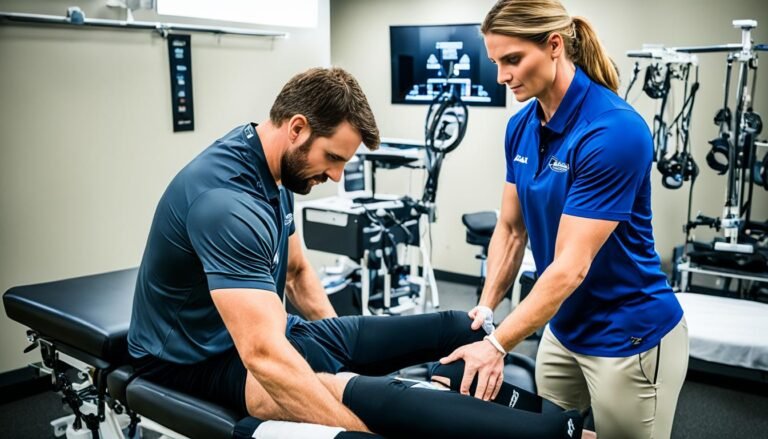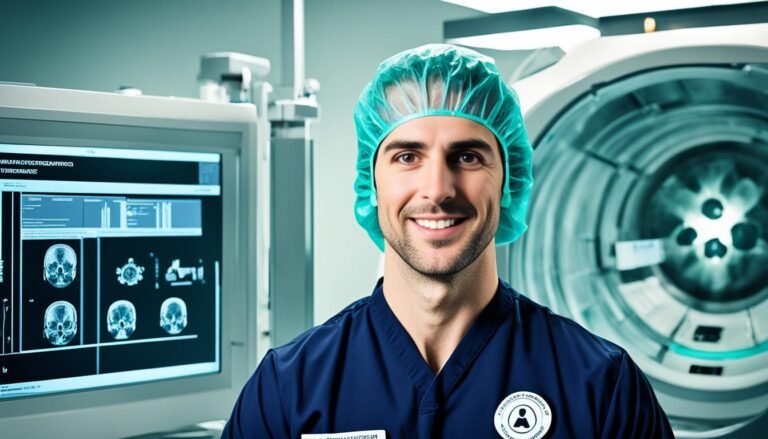What is Advanced Trauma Life Support (ATLS)?
Advanced Trauma Life Support (ATLS) is a program created by the American College of Surgeons (ACS). It has reached over 1 million doctors worldwide. These doctors practice in more than 80 different countries.
ATLS offers a set method to handle patients with severe injuries. It helps quickly assess the patient’s condition, focus on stabilizing them, and then decide on the best care or next steps. It’s key in both big city hospitals and small rural ones, making a big difference in patient outcomes.
Key Takeaways:
- ATLS is a CME program developed by the ACS Committee on Trauma.
- It provides an organized approach for evaluating and managing seriously injured patients.
- ATLS has been taught to over 1 million doctors in more than 80 countries.
- It aims to rapidly assess and stabilize patients, determine the need for higher levels of care, and arrange for definitive care.
- ATLS is applicable in both large urban centers and small rural emergency departments.
Importance of ATLS
ATLS is crucial because it gives all trauma team members a common base of knowledge. It makes sure the first doctor on the scene has a big chance to help the patient. ATLS is known all around the world. Many ATLS activities happen outside the US and Canada.
The program guides doctors on how to check and treat trauma patients in a smart way. This means patients get the same great care no matter where they are. It helps save lives by teaching healthcare workers how to deal with the most serious injuries first.
ATLS sets a clear path for taking care of trauma patients. It makes sure healthcare workers use the best methods, which makes patients safer and reduces mistakes in urgent times.
ATLS doesn’t just help one patient at a time. It also boosts the abilities of whole healthcare systems to care for trauma patients. By using ATLS, hospitals and trauma centers can better use their resources. This leads to better results and fewer deaths. The emphasis on good evidence helps trauma care get better all over the world.
Plus, because ATLS is so widely known and used, healthcare teams can work together smoothly. This happens even if they’re from different places or have different jobs.
In trauma care, acting fast is key. ATLS equips healthcare providers to make quick, smart choices. This means patients get help right when they need it, which can make a big difference in their recovery.
ATLS Certification and Training
To get ATLS certification, healthcare workers need to finish the course. It’s for doctors and other pros who treat trauma patients. The course teaches a proven way to handle injured people safely and effectively.
The ATLS course covers many key areas, like checking patients, airways, and different injuries. It helps through lectures, talks, and hands-on practice. This way, everyone learns how to quickly help and stabilize trauma patients.
ATLS courses are held in many places, making it easier for healthcare pros to join when they can. You can find course info on the American College of Surgeons (ACS) website. This makes it all very convenient.
Finish the ATLS course and get certified for four years. This shows you’re good at caring for trauma cases. There are update courses too, to keep your skills sharp and current.
In ATLS training, healthcare providers learn the essential skills and knowledge needed to deliver efficient trauma care. By completing the course and obtaining ATLS certification, participants can enhance their ability to provide immediate and effective care to critically injured patients.
Getting ATLS certified boosts your trauma care skills. It’s a gold standard for treating trauma patients. And it guides decisions in tough situations, where fast and right actions matter most.
ATLS Guidelines
Advanced Trauma Life Support (ATLS) has set guidelines for helping severely injured patients. It teaches one safe way to treat people with trauma. However, other effective methods are also available.
ATLS stresses the need for quick and accurate patient assessment and care. The main goal is to save lives. It focuses on figuring out what the patient needs right away.
ATLS also makes sure that patients get the best care during every step. This includes when they’re evaluated, treated, and transferred between hospitals.
ATLS Techniques
Healthcare providers learn key techniques in the ATLS course for traumatic injuries. These methods are crucial for saving lives. They include:
- Primary Survey: This starts with a primary survey, looking for immediate threats to life. Providers check the airway, chest for breathing problems, and the blood volume.
- Secondary Survey: The second step is a detailed check for injuries. It includes past medical history, exams, X-rays, and blood tests. ATLS teaches how to do this in a logical way.
- Definitive Care: Definitive care ensures that patients’ exact needs are met. It includes working with specialists and preparing for surgeries. Follow-up care is also planned.
These ATLS methods give a standard way to manage trauma. This means patients get the same high-level care wherever they are treated.
“ATLS guidelines offer a clear approach to treating trauma. They help medical teams do everything safely and in a standard way. This leads to the best care for patients.”
Following ATLS guidelines helps healthcare workers improve how they handle trauma. This means better outcomes for patients and less risk from severe injuries.
| Key Points | Benefits |
|---|---|
| Safe and standardized approach | Consistent care for trauma patients |
| Rapid and accurate assessment | Prompt identification and management of life-threatening conditions |
| Appropriate arrangements for inter-hospital transfer | Efficient and coordinated transfer of patients to higher-level facilities |
| Optimal care throughout the patient’s evaluation, resuscitation, and transfer process | Improved patient outcomes |
ATLS Program Development
The ATLS program dates back to 1976, a pivotal year. A plane crash survival was the turning point for Dr. Jim Styner. Struggling with trauma care, Dr. Styner saw the vital need for a fresh patient management method.
“There had to be a better way to care for the severely hurt. A method applicable globally was crucial, no matter the setting or tools available.”
This led Dr. Styner to launch the inaugural ATLS Course in 1978. This course aimed to arm medical workers with skills and insights to handle trauma with a unified approach.
Since its start, the ATLS initiative has made waves, reaching over 80 countries and training more than 1 million doctors worldwide. Regular updates keep the program current with new trauma care findings, fitting seamlessly into global, diverse, and fact-driven care approaches.
Developing ATLS was a joint effort by the American College of Surgeons (ACS) Committee on Trauma, trauma surgeons, and specialists from various medical fields. This teamwork keeps ATLS cutting-edge, adapting it to the changing medical scene and adopting top practices.
ATLS has set a worldwide benchmark in trauma education through its thorough development. It equips healthcare givers with the skills and wisdom needed to save trauma patients. The program’s positive effects continue to shape trauma care around the globe.
ATLS Staff and Complementary Courses
The ATLS program is supported by a group of experts. These individuals, known as ATLS staff, are key to the program’s success. They are trauma care specialists who lead the ATLS Student Course. Their deep knowledge helps educate the participants.
Showing great potential and a love for teaching opens new opportunities. The ATLS Instructor Course is a special chance for these individuals. It teaches them how to become instructors too. After completing this course, they can teach the ATLS Student Course. This spreads life-saving skills even further.
There are extra courses beyond the core ATLS program. These are for healthcare providers who handle trauma care. The Trauma Evaluation and Management (TEAM) course is one such example. It’s for medical students and teaches them critical skills for treating trauma patients. This tailors the ATLS program to a variety of healthcare roles and experiences.
ATLS is committed to educating healthcare providers with dedicated staff and extra courses. This commitment improves care and leads to better patient results. Thanks to the ATLS staff and varied educational chances, healthcare workers can continually boost their abilities.
ATLS Course Content
The ATLS course is for a mix of people. It caters to every learning style. The Student Course is interactive and hands-on. You learn in a way that feels real. This makes it easier to retain new knowledge and skills.
Finish the Student Course and get a certification for four years. It shows you’re good at trauma care. You can use the skills you’ve learned in real life.
Doctors can do the Student Refresher Course to keep their certification. It’s quick and flexible, lasting either a half or full day. This course covers updates in trauma care, helping doctors stay sharp.
ATLS covers many aspects of patient trauma. It teaches basic ideas, sorting patients, and tests on what you know and can do. The mix of study and actual practice helps healthcare workers care for trauma cases better.
ATLS Course Formats
The course comes in different types to fit healthcare workers’ needs. There’s now a blended option. It mixes online learning with practical sessions.
This mix means you can learn at your own speed. This is great for those juggling work and study. The quality of teaching stays high, even if the teachers aren’t in the same place as you.
ATLS Refresher Course
Doctors with an ATLS cert can take the Refresher Course to renew it. It helps stay on top of trauma care. This way, they can keep providing great care to patients.
The course reviews essential trauma care info. Doctors get to brush up on their skills in a safe space. After, they’ll feel ready to face trauma cases with confidence.
ATLS and Continuing Medical Education
The ATLS program is a great way for healthcare workers to keep learning. It’s recommended by both the American College of Surgeons and the Royal College of Physicians and Surgeons of Canada. Doctors and other healthcare pros can get credits for important learning activities.
This program follows the highest medical standards. Taking part helps healthcare workers earn important educational credits. These are recognized as top-notch by the American Medical Association.
“I found the ATLS program to be an excellent platform for continuing medical education. The program’s emphasis on trauma care and critical decision-making has greatly enhanced my clinical skills and contributed to my ongoing professional development.” – Dr. Sarah Thompson, Emergency Physician
Going to live ATLS workshops can also earn doctors important credits. These credits are key for keeping up with their profession and keeping their licenses.
The ATLS program is known all over the world. It’s a chance for healthcare workers, no matter where they are, to show they’re committed to learning. By earning these credits, they show they care about giving the best care possible.
| Benefits of ATLS Continuing Medical Education | ATLS MOC Program | AMA PRA Category 1 Credits™ |
|---|---|---|
|
|
|
Conclusion
Advanced Trauma Life Support (ATLS) was created by the American College of Surgeons (ACS) Committee on Trauma. It’s a CME program for healthcare workers. It teaches them how to care for people who are badly hurt in a structured way.
Following the course gives healthcare workers the know-how they need. This helps them give the best care to trauma patients. The program helps trauma care become better all over the world. Doctors can also earn AMA PRA Category 1 Credits™ by taking these courses.
ATLS is extremely important for those who deal with trauma patients. It ensures everyone gets the same top-notch care. By giving providers the right tools and knowledge, ATLS is about saving lives and bettering the health of the seriously injured.







